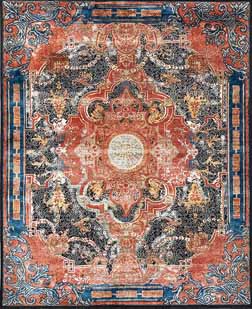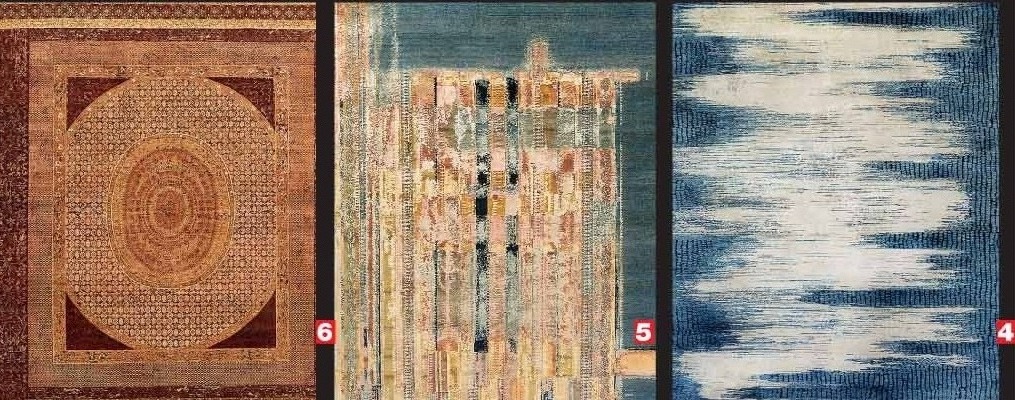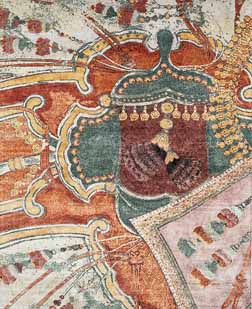What results from the union of a 100-year-old illustrious luxury carpet-making tradition with some of the best creative minds of our country is a story of unique design, crafted by legacy and told with pride. And these are the stories that we became privy to when we tuned in for a special chat featuring Obeetee’s Rudra Chatterjee and designers Tarun Tahiliani, Abraham & Thakore, Raghavendra Rathore, Shantanu & Nikhil and JJ Valaya for AD Weekender by Architectural Digest India. Marking the day when Obeetee’s shopping website also went live, Rudra recounted how their ‘Proud to be Indian’ collaboration began with each aforementioned designer and what we can look forward to from them, at a 60-minute web discussion on September 25. Amidst stories of how Tarun’s chikankari was translated on to carpets and even found a buyer in Paul Simon (of Simon & Garfunkel) to Shantanu & Nikhil’s upcoming collaboration with Obeetee that envisions the kind of carpets that generals in an Indian war room would stand on while strategising the making of India, fused with their pre-1947 aesthetics of spunky insignias, or even Rathore’s contemporarising of traditional motifs such as royal coat of arms in an asymmetric manner — Rudra opened up about the company’s desire to safekeep Indian craftsmanship and heritage through these collaborations. Excerpts:

Coat of Arms by Raghavendra Rathore X Obeetee Obeetee
Proud to be India X Obeetee
Rudra Chatterjee: Obeetee is not trying to pivot into fashion but we are trying to recognise that India is today the home of carpets and that India has a design heritage that has never been used on carpets. This incredible set of designers bring forth India’s fashion heritage that has been developed over the years. We have incredible craft and material that have been used for centuries and are being used in newer ways now by these designers who are reinterpreting and innovating regularly.
The whole point of a carpet is not to leave it in a room that you don’t use — it lives and grows with you. With this series of collaborations, we wanted to talk about the material, craft and also the people because each of these carpets is at least 70 per cent about the people — think of doing the carpet knots, 300 times on each 1sq-inch of area. So we brought on incredible design talent and looked inward for once and wanted to collaborate with the finest-quality material in order to be able to make living pieces of art. These designers represent different parts of India as well so celebrating our design heritage with these iconic figures was the idea.
Tarun Tahiliani: I love carpets! They live for centuries if they’re looked after and though it was a chance encounter with Obeetee for me, I thought it was a great idea. Every time I went shopping for carpets, I always liked the reverse side because everything looked too bright otherwise. It is also interesting as a designer to work on a new medium. When I met the design team at Mirzapur and saw the possibilities and washes, it brought something to life that was fantastic. It was fun but you had to have a lot of patience because making carpets is not about instant gratification of making a collection in two months. I lost track of when we started and when the first swatches arrived. It was something beautiful to do and fed from our design collections.
JJ Valaya: Before I got into fashion, I remember my mother going to buy a carpet at Obeetee, which still exists. If I were to give a couture alternative to carpets in India, it had to be Obeetee. So I am looking forward to developing something fantastic with them.
Raghavendra Rathore: Besides the legacy of Obeetee, the assurance of the quality that the articulation of your thoughts would be materialising into was a very appealing thought. I don’t think there is any other business model that we would like to be associated more with when it comes to the transfer of wealth through design. The philosophy of this collection aligned very well with what we were doing as a company then.
Shantanu & Nikhil: Rudra had visited our factory back in 2014-15, exploring opportunities. We spent quite a few days and weeks together till we decided that we were not ready. As a brand, we were still evolving but we knew that if we were to extend ourselves beyond clothing, then it had to be with Obeetee. A year after that, we tweaked our philosophy to bring in muted maximalism and the kind of storytelling we did was the nostalgia of India pre-1947, with military influences. We want to bring in a fiercer side of India — very anti-trend to what the traditional side was. We then reached out to Rudra. That’s where the symbols, insignias, geometric textures, linearity, playing with metallic sheen but in a subdued manner, came in. So you’ll see the other side of India in this collaboration where heritage meets spunk.
David Abraham & Rakesh Thakore: We were excited when we were asked for this collaboration because textiles are a very important part of our work and carpets are one of the most luxurious textiles that are still being woven today, particularly by hand. The amount of work into making a carpet also makes the possibilities endless and allows you to create surfaces that don’t repeat. We really enjoyed the process.

(L-R) Tarun Tahiliani’s chikankari collection with Obeetee, Pochampally by Abraham & Thakore X Obeetee, Leheriya by Abraham & Thakore X Obeetee Obeetee
Craftmanship and ideas
Tahiliani: We could not narrow it down so we had three inspirations going on. The first was chikankari with very muted colours like beiges, taupes, jades, pale ivory and when we did the launch, we showed our chikankari saris against these carpets, which made it look like one thing turned into the other. The second thing we worked with were broken miniature frames — the carpet that I am sitting on right now has a motif off its centre and the border feels like it has many different ones splashed together and then aged. The third one was out of abstract paintings that I do and they managed to get the drip technique. We are now doing indigo and experimenting further.
Abraham & Thakore: We were trying to find a design vocabulary that we could use. Most carpets in this part of the world derive that from central Asia or Persia or the other school of carpets that are woven in India and are international in style. We thought of looking at Indian textiles to see if we could derive something from there. Ikat, bandhini, sari borders from woven traditions and prints, and calligraphy were the collections we did and Obeetee’s team helped us bring those to life.
Shantanu & Nikhil: We took a long time to get into the skin of it and it had to be a process of storytelling. Imagine a war room with generals where they are chalking out a plan for the country. What carpet would they stand on? And that was the thought. Geometrical lines cutting across the old maps and borders of India, insignia or crests and elements like those were brought into this war room where India was built. Making carpets is incredible because you might have something in your head and then the swatch comes, which could be anything. You will see contemporary, decadent India meeting a slightly vintage outlook.
Rathore: The inspiration was to understand the customers, trying to find a slot that was unique and building an emotion that we wanted to present. So rituals, palaces, architecture, identities of royal houses and coat of arms became the mood board. But we made it in a way that they were asymmetrical but were still classic. In a summary, it was a classic adventure with a very strong desire to provide something that the market is still looking for. There was a lot of learning for us as well — Scandinavian styling was used to create old motifs from Jaipur walls so a lot of hybrid of rituals, palaces and coat of arms that we have used in most of our works.

Durbar Gadi Masand by Raghavendra Rathore X Obeetee Obeetee
Chatterjee: These are not mass-scale products. We started by having limited editions for each of these designs and we would actually prefer to have a second collaboration instead of making more of the same. We don’t want to walk into everybody’s homes and see the same rugs. It has to feel like something you have owned and built over time with the rest of your furniture and home. The beauty was that these products had a global appeal. I remember we were so excited when Paul Simon (of Simon & Garfunkel) went and bought Tarun’s rug, the first week after it was launched. We had a phenomenal party with Abraham & Thakore’s collection. It got stuck with Raghu’s collection for which we had planned a New York launch in April but everything stopped by then. It was first launched in Delhi and we were seeing different customers with different reactions. Today, we launch all these rugs online for the first time. So it will be another platform, texture and way of looking at these products.
We want to make customers appreciate the product so on the website, we have different home settings and you look at the story of Obeetee — you see Queen Elizabeth II and Jawaharlal Nehru and that’s the history of a company celebrating 100 years. We want people to understand the quality of the carpet and that they will be supporting sustainability, a the tradition of handmade and something that has been around for a 100 years.












